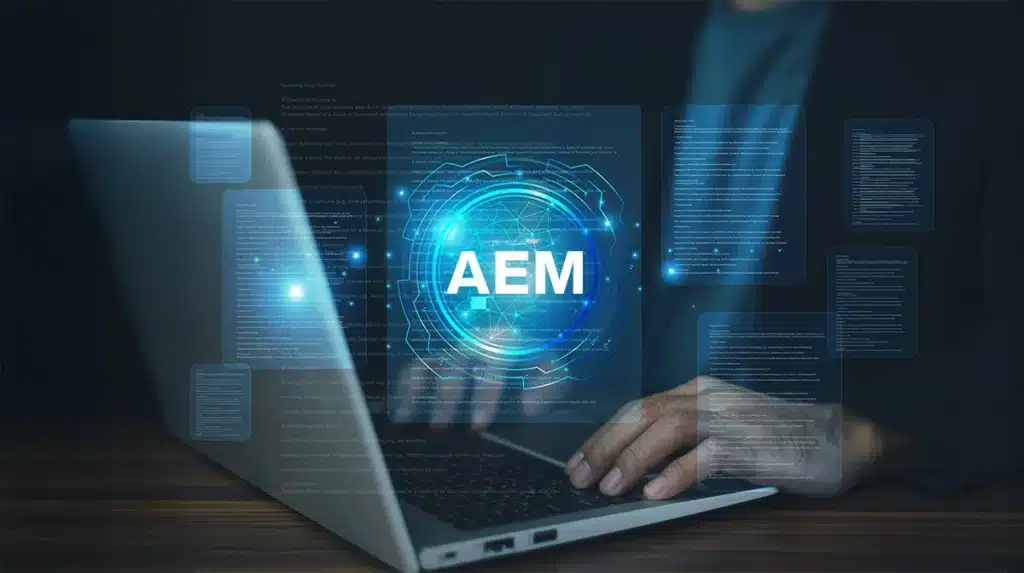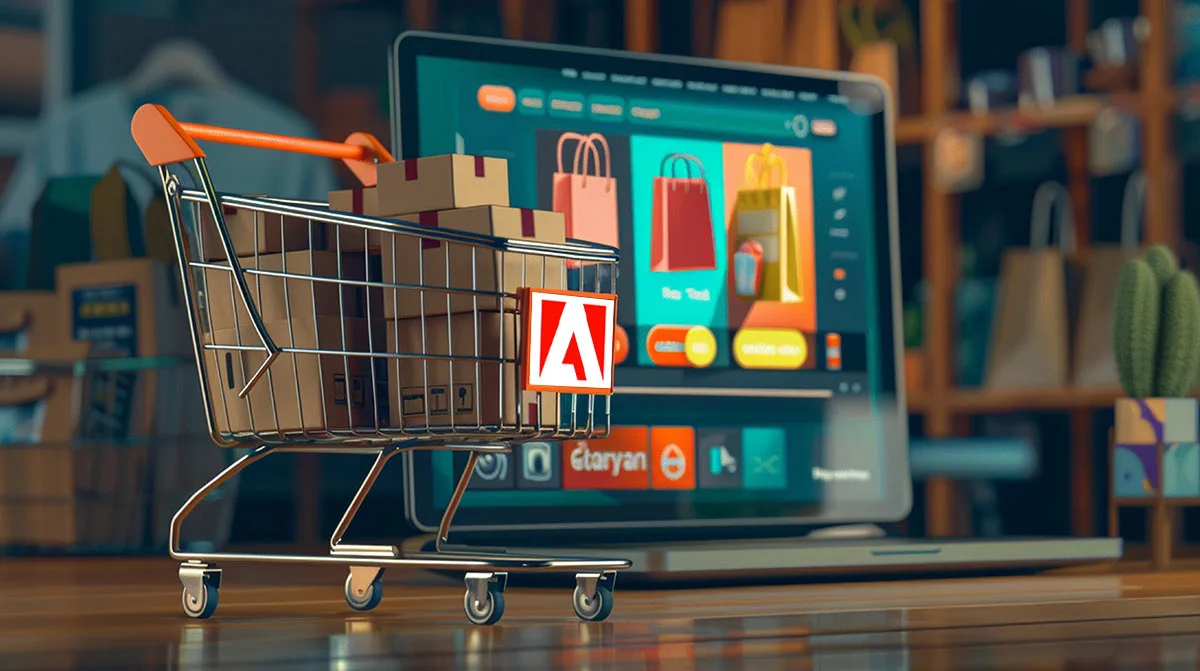Imagine a world where your marketing team launches 65 hyper-personalized campaign variations in a single week, achieving a $1.2 million increase in Q3 revenue simply because your content could adapt instantly. This is not a dream.
This is the calculated, measurable performance and supreme agility you unlock with Adobe Experience Manager (AEM), the world’s leading digital experience platform.
AEM is more than a technology installation. It is the central, strategic investment that fuels true digital transformation. It requires a meticulous, personalized, and proven roadmap designed to deliver not just a working website, but unprecedented, quantifiable business value across the entire enterprise.
This in-depth guide is your strategic playbook for navigating the complexities, decommissioning costly legacy systems, and ensuring your AEM rollout becomes the success story that defines your tenure.
Part I: The Strategic Mandate of AEM: Why Now is Different
Customers today demand instant, relevant experiences. Generic content is a recipe for irrelevance. AEM addresses this by transitioning your organization from a slow, site-by-site publishing model to a unified, AI-orchestrated content ecosystem.
Recognized year after year as the DXP leader by Gartner, AEM leverages the power of Adobe Sensei GenAI and a modern, composable architecture to turn complex, multi-channel customer journeys into streamlined, profit-driving processes.
The strategic decision to adopt AEM is rooted in a compelling, measurable reduction of friction and increase in revenue velocity:
The Enterprise Value Matrix: From Challenge to ROI
| Your Current Enterprise Challenge | The AEM Cloud Service Solution | The Measurable, Quantifiable Impact for Your Business |
| Content Silos and Asset Sprawl | Adobe Experience Manager Assets (AEM Assets): Centralizes all media into a single, intelligent repository (DAM). | Content Velocity and Cost Reduction: Cuts global campaign execution time by up to 70% and slashes duplicate asset creation costs. |
| High TCO and Unpredictable Downtime | AEM as a Cloud Service (AEMaaCS): Fully elastic, autoscaling, and continuously updated SaaS model. | Reduced Operational Risk: Guarantees near-zero downtime, shifts spend from unpredictable CapEx to predictable OpEx, and minimizes security patching labor. |
| Generic, One-Size-Fits-All Experiences | AI-Powered Personalization (Adobe Target and Sensei): Delivers tailored content based on real-time behavior. | Revenue and Conversion Growth: Drives web and mobile conversion rates up by 25% – 40% by serving the right content at the exact moment. |
| Future-Proofing New Channels (AR, IoT) | Composable/Headless Architecture: Decouples content creation from presentation layers. | Agility and Innovation: Enables seamless content delivery to emerging channels, guaranteeing that today’s investment supports tomorrow’s technology. |
| Slow Authoring and Developer Bottlenecks | AEM Sites and Edge Delivery Services: Modern, low-code component development and rapid, pre-configured content delivery. | Increased Productivity: Speeds up time-to-market for new features, empowering marketing teams to launch pages independently in minutes, not weeks. |
Part II: Building the Ironclad Foundation: RFP and Strategic Partner Selection
The most critical step in an AEM program is defining success and choosing a strategic guide. A failed implementation is costly, not just in budget but also in lost revenue and irreversible damage to organizational confidence.
Mandate One: Defining Success in Your RFP (The Outcomes Contract)
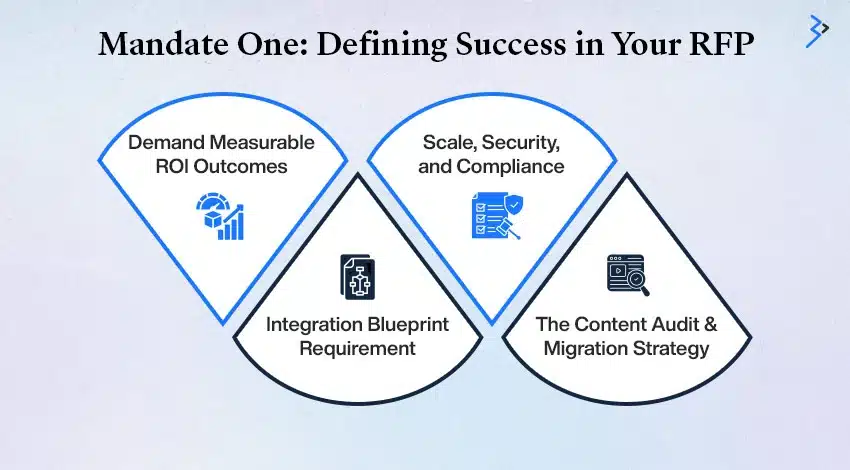
Your Request for Proposal (RFP) must be a contract for business outcomes, not a shopping list of features. To ensure your investment pays off, mandate the following four focus areas:
- Demand Measurable ROI Outcomes: Shift the focus from technical deliverables to business results. Instead of asking for the Multi-Site Manager (MSM) feature, your RFP should state: “Implement a centralized content management framework to reduce the operational cost of managing 10+ regional sites by 50% within the first 12 months.”
- Integration Blueprint Requirement: AEM doesn’t live in a vacuum. Demand a clear, detailed blueprint for its API-first integration with your existing mission-critical systems: CRM (Salesforce, Dynamics), Commerce (SAP, Magento), and ERP. The partner should have expertise in building real-time data flows to enable personalization.
- Scale, Security, and Compliance: Detail your non-negotiables: peak traffic projections, the expected volume of digital assets (millions), global security standards (ISO, SOC 2), and mandatory compliance (GDPR, CCPA, HIPAA). Your partner must demonstrate that their technical roadmap meets these regulatory and performance thresholds from Day One.
- The Content Audit and Migration Strategy: Content migration is often underestimated. A comprehensive plan with a content audit is required to identify “dead” or redundant assets. Demand an approach that leverages automated tools (like the Content Transfer Tool) to ensure data integrity and a structured process for enriching old content with AI-ready metadata before it is migrated.

Read More – How Retail Businesses Use AEM for eCommerce and Customer Engagement
Mandate Two: Selecting Your Strategic Partner
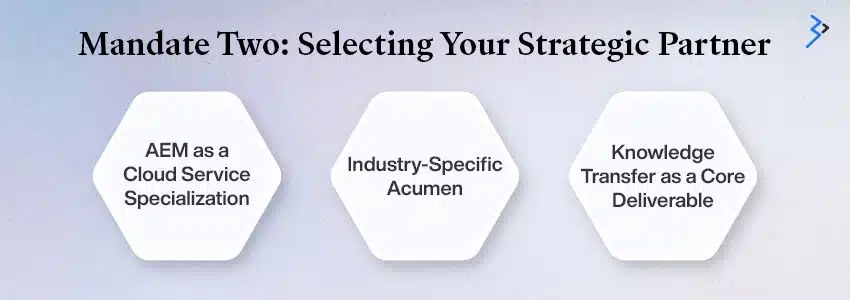
The right AEM partner is an extension of your leadership team. They’re a strategic advisor who ensures your company is empowered for long-term ownership. Look beyond a vendor and seek a collaborator with:
- AEM as a Cloud Service Specialization: The AEM architecture has evolved. The partner must demonstrate a proven, successful history of implementing the cloud-native, immutable architecture of AEMaaCS, not just legacy AEM 6.x. Ask for case studies focused on elastic scaling and zero-downtime deployments.
- Industry-Specific Acumen: A healthcare implementation is fundamentally different from a retail one. Choose a partner who has successfully delivered AEM solutions in your specific vertical and understands your unique regulatory environment and customer journey patterns.
- Knowledge Transfer as a Core Deliverable: A successful implementation is one in which your internal team (IT, Marketing, Operations) can manage and extend the platform independently. Insist on a structured, role-specific Center of Excellence (CoE) model and hands-on training that guarantees self-sufficiency.
Part III: Technical Excellence and Agile Execution
Architectural decisions made in the first six months dictate your long-term Total Cost of Ownership (TCO) and your speed of innovation.
The Cloud-Native Architecture Playbook
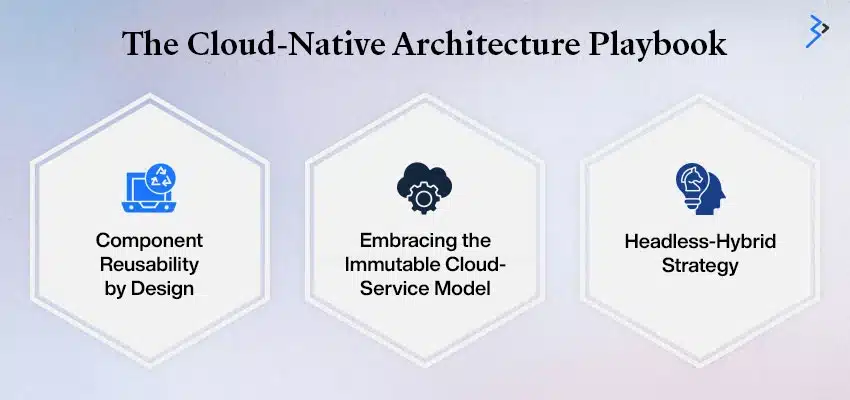
Your AEM implementation must be modular, resilient, and cloud-first:
Component Reusability by Design
This is the key to content velocity. Develop a standardized, highly reusable library of Experience Fragments (reusable page sections) and Content Fragments (structured, reusable content blocks). This approach ensures brand consistency across global sites and helps marketing teams assemble new pages in minutes using drag-and-drop. Avoid over-customization, it undermines the platform’s ability to seamlessly integrate new Adobe features and increases technical debt.
Embracing the Immutable Cloud-Service Model
AEMaaCS eliminates the need for manual, risky upgrades. Its continuous integration/continuous deployment (CI/CD) pipeline, managed through Cloud Manager, enforces automated code quality, security scanning, and performance auditing before deployment. This immutable infrastructure model is not just a technology choice but a risk management strategy ensuring security and stability.
Headless-Hybrid Strategy
Adopt a hybrid approach to content delivery. Use the visual editor (Headful) for your primary marketing website, but use the powerful, structured APIs (Headless) to syndicate content to your mobile app, internal knowledge portals, and emerging channels (e.g., in-store displays). This maximizes content reuse and future-proofs your investment.
Read More – Step-by-Step Guide to Implementing Adobe Analytics in AEM
Agile Execution: The Continuous Delivery Pipeline
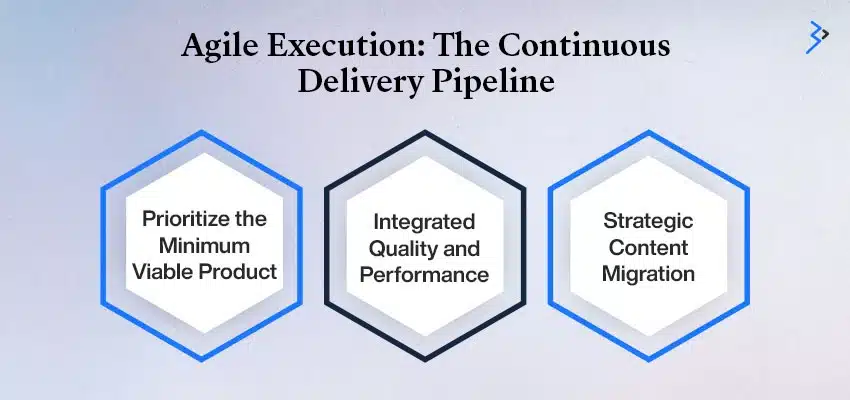
We manage the implementation using a data-driven, Agile methodology, focused on delivering working features continuously:
- Prioritize the Minimum Viable Product (MVP): Focus on a “Quick Wins” roadmap. Launch a foundational set of components and a pilot site first to show immediate, tangible results and gather crucial user feedback early.
- Integrated Quality and Performance: Embed Quality Assurance (QA) and security testing into every sprint. Use the Cloud Manager pipeline to run automated performance audits against key speed metrics. A two-second page load time is a business KPI, not just a technical metric.
- Strategic Content Migration (The $1M Mistake Avoidance): Do not attempt a “lift and shift” of all legacy content. This only transfers old problems to the new platform. Follow the 80/20 Rule: prioritize the 20% of content that drives 80% of your business value. Leverage the Adobe Content Transfer Tool (CTT) for efficient, staged migration, treating the migration itself as a clean-up and optimization event.
Part IV: Securing Long-Term Value and Exponential ROI
The value of AEM only begins at launch. Sustainable success comes from a commitment to Continuous Optimization and Governance.
Driving ROI with Personalization and AI
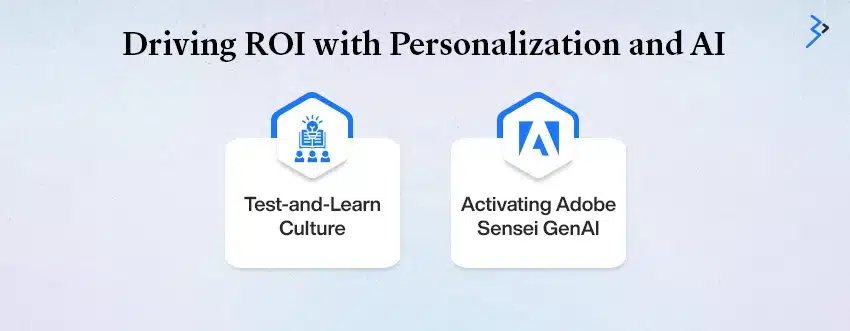
The true competitive advantage of AEM lies in its ability to integrate with the entire Adobe Experience Cloud, notably Adobe Target and Adobe Analytics, to execute personalization at scale:
- Test-and-Learn Culture: Personalization is a perpetual experiment. Utilize AEM’s integration with Adobe Target to run continuous A/B and Multivariate Tests. Use the data from Adobe Analytics to constantly refine customer segments and identify high-value opportunities for tailored content. The goal is to move from manual testing to AI-driven optimization.
- Activating Adobe Sensei GenAI: Integrate AI tools to accelerate content production. Use Sensei to automatically tag and categorize your massive Digital Asset Management (DAM) library, making assets instantly searchable and reusable. Deploy Generative AI Development Services to create copy variations for personalization tests, simultaneously driving content velocity and relevance.
Governance, Sustainability, and the Future

To ensure your investment remains secure, scalable, and relevant for years to come:
- Robust Governance Model: Establish a strong, decentralized governance framework. Define clear roles and responsibilities, e.g., who owns the content strategy, who approves component development, and who monitors performance. This prevents “component sprawl” and ensures the platform remains clean and scalable. Enforce granular security protocols and conduct continuous monitoring to ensure compliance 24/7.
- The Center of Excellence (CoE): Formalize the internal AEM team into a CoE. This CoE is the keeper of best practices, the first line of support, and the internal champion for new features. It’s the engine for sustainable adoption and internal competency building.
- The Optimization Feedback Loop: Use the performance data from AEM as a Cloud Service and Adobe Analytics Consulting Services to drive your ongoing roadmap. Treat your AEM platform as a living product, not a fixed project. Your platform must continuously evolve with emerging customer needs, ensuring you are constantly leveraging the latest features from Adobe’s continuous release cycle.
By following this personalized, outcome-driven roadmap, your AEM implementation will transform from a complex IT project into the agile, scalable engine of your enterprise’s digital growth, delivering clear, measurable value to the bottom line.
Read More – A Guide to Implementing AEM for Your Business
The Conclusion: Partnering for AEM Implementation Excellence
The success of your AEM project depends not just on the software but also on the strategic partnership guiding its execution. The goal is to move beyond simple technical installation to realizing true digital transformation and measurable financial results.
As an Adobe expert and top-tier digital consulting partner, Brainvire architects secure, scalable digital ecosystems focused entirely on your business growth, moving beyond simple implementation.
Future-proof your AEM investment and empower your teams with sustainable adoption today.
Frequently Asked Questions
AEM’s hybrid approach offers both. Traditional (or Headful) combines content with presentation, enabling visual authoring. Headless decouples content from the frontend via APIs (like GraphQL), enabling content reuse across any channel (web, mobile, IoT).
AEM uses GenAI through features like “Generate Variations” in Sites to create personalized copy for quick testing. AI Assistant provides context-aware help, and Smart Tags in Assets automatically apply descriptive metadata, speeding up content velocity.
The main factors are licensing fees, the complexity and volume of content migration, the scope of customization and third-party integrations (e.g., analytics/commerce), and the ongoing cost of training and specialized development support.
The native integration streamlines the content supply chain by connecting content creation (in Workfront) with content delivery (in AEM). This helps teams manage tasks, get approvals, and maintain brand consistency from a single workflow.
HTL is the recommended, secure templating language for AEM. It replaced JSP and enforces the separation of concerns. It is crucial for developing robust, readable, and performant AEM components and frontends.
Related Articles
-
AI-Powered Personalization: Integrate Adobe Commerce with Real-Time CDP
Think about the last time you shopped online. Did the website feel like it “got” you, almost like it knew what you wanted before you even searched for it? It
-
The Composable DXP Advantage: Building Agile Digital Experiences with Adobe Solutions
In a hyper-competitive digital landscape, customer expectations are rising fast. Users demand personalized, seamless experiences—whether on a website, mobile app, or smart device. They want these interactions to be instantly
-
How to Set Up an Adobe Commerce Store: A Step-by-Step Guide
Summary Setting up an online store is your first step towards the entrepreneurial journey. You’re filled with ideas and want to execute everything to ensure the best for your customers.

